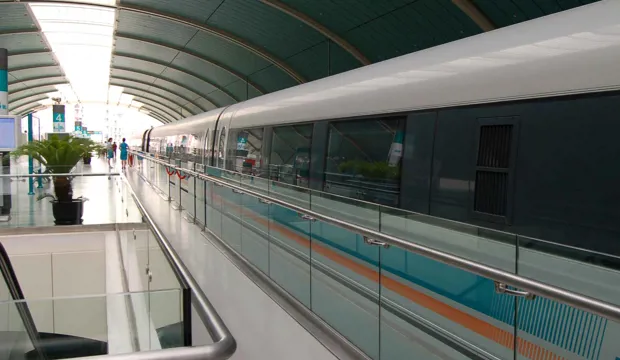
Design a model vacuum tube train?
Choose from a range of equipment to design a model tube train
A costly, and sometimes very long, aeroplane journey is currently your only option if you intend to travel a long distance. However, what about in the future? One method that has been proposed is the vacuum tube train. This may be able to reach speeds of 4,000 mph, but is it a realistic option?
Learn about train design and improve your engineering skills with this fun STEM activity!
Activity: Design a model vacuum tube train?
In this activity students will design a model vacuum tube train. Students will have to decide on how to get a ball to travel through a tube as quickly as possible without the help of gravity. They will then look at the forces that would act on a real vacuum tube train.
Students will work in small groups to engineer a high-speed vacuum tube train. Groups will need to design a way of getting a ball (the train) to travel from one end of the plastic tube to the other as fast as possible.
Students should be supplied with a variety of marbles and ball bearings in various sizes. They should be allowed to choose which sizes they want (this will depend on the method they choose). Options may include using a magnet to pull the ball, using force from a metal rod or air from a pump to push it. Learners can’t rely on gravity – the tubing needs to be placed on a level desk or floor.
Groups are asked to record the speed and then modify their design to make it faster. They will need to use stop clocks to measure time and then calculate speed. If you have data-loggers to measure speed these can be used instead. Students should understand the need for repeating their measurements and they should record them in a table.
Groups can modify the ball if they wish. They might want to make it more aerodynamic by using paper or by using a lubricant.
As an optional extension, students could modify their design so it has a safe stopping mechanism. Alternatively, students could write an explanation as to why air resistance is not a problem in a vacuum tube train and why this is an advantage.
How long will this activity take?
This activity will take approximately 50 minutes to complete.
Tools/resources required
- Projector/whiteboard
For each group:
- 1m length of plastic tubing
- Magnetic ball bearings and marbles of various sizes
- Magnets of various shapes including strips
- Balloon/bicycle pump
- Stop clock or data loggers with light gates
- Metal rods and springs
What is a vacuum tube train?
A vacuum tube train, also known as a vactrain, is a proposed design for train transportation. The train would use maglev technology to run in partly evacuated tubes or tunnels. Reduced air resistance could allow vacuum tube trains to travel at very high speeds – up to 4,000 mph!
Suggested learning outcomes
By the end of this activity students will be able to design a model vacuum tube train and they will be able to use a force diagram to show the forces interacting on a real vacuum tube train.
Download the free Can you design a model vacuum tube train? activity sheet below!
All activity sheets, worksheets and supporting resources are free to download, and all the documents are fully editable, so you can tailor them to your students’ and your schools’ needs.
The activity sheet includes teacher notes, guidance, useful web links, and links (where appropriate) to the national curriculum in each of the four devolved UK nations; England, Northern Ireland, Scotland and Wales.
Please share your classroom learning highlights with us @IETeducation.
Available Downloads

Activity overview
Activity description, teachers' notes and curriculum links.

Presentation
What are the forces acting upon a train?

Handout
Student handout where students are tasked with designing and building a model vacuum tube train.

How things fly - Podcast
Produced by Fun Kids Radio as part of the Techno Mum series, which aims to explain how things fly.


